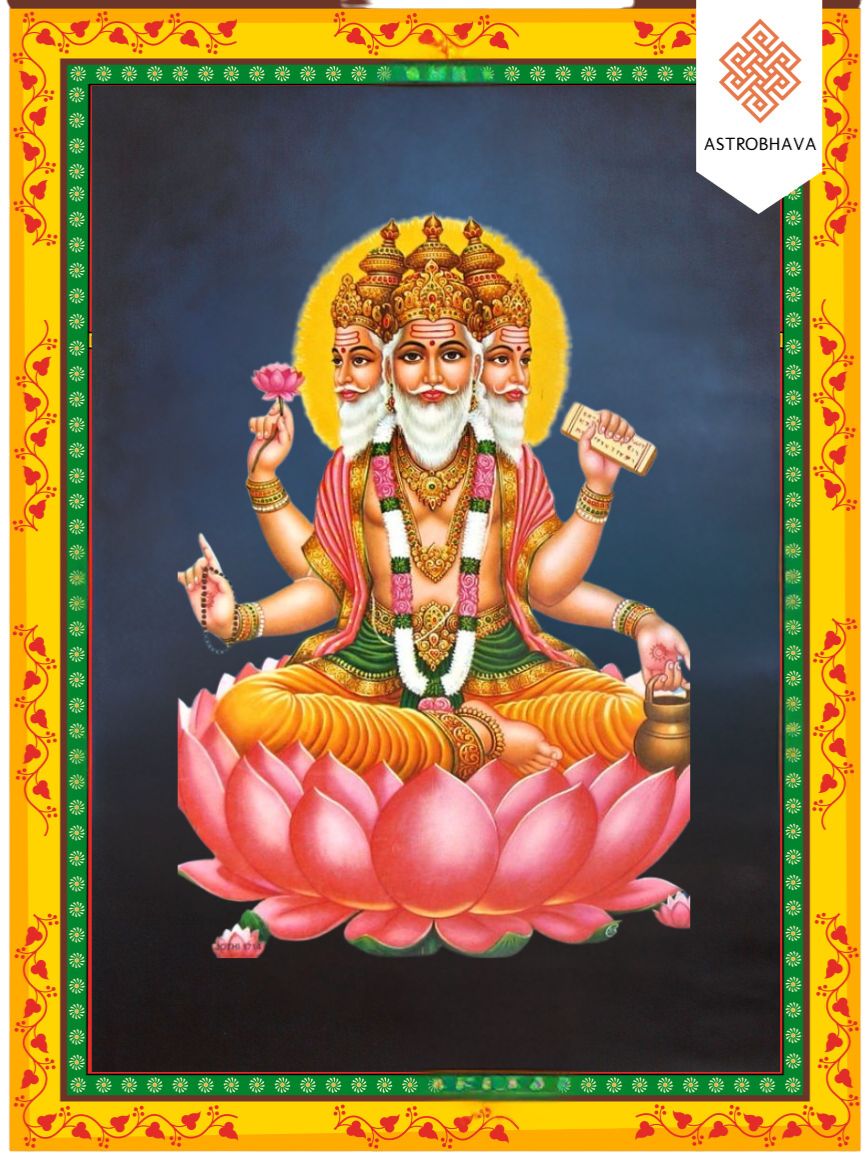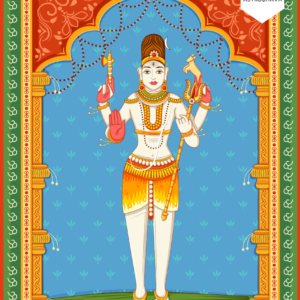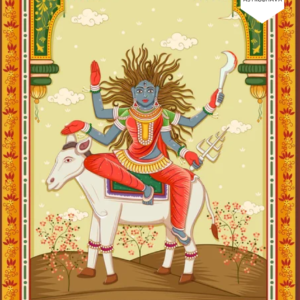
Pavamana Mantra
Mantra Dedicated to the Supreme Brahman
The Pavamana Mantra is a profound spiritual invocation found in the Bṛhadāraṇyaka Upanishad, one of the oldest and most revered scriptures in the Vedic tradition. Unlike many other mantras that are directed toward specific deities such as Shiva, Vishnu, or Devi, this mantra is unique in its universal appeal and philosophical depth. It is not a prayer to a personalized god but a soulful request to the Supreme Brahman, the unchanging, formless, eternal consciousness that is the source and substratum of all creation.
This mantra emerges from the heart of Vedanta philosophy, where Brahman is considered the only reality, and the material world is seen as a transient appearance. The Pavamana Mantra encapsulates the spiritual journey of the seeker — moving from ignorance to knowledge, illusion to truth, mortality to immortality. It is a prayer for inner evolution, where the aspirant seeks guidance from the Divine Source to transcend the limitations of human existence.
Here, Brahman is not depicted with attributes or form. It is the Nirguna Brahman — the infinite reality beyond all characteristics, beyond the duality of good and evil, light and darkness, birth and death. As such, the mantra is a sublime request for divine grace to move toward this transcendental truth. The goal is liberation (moksha), the ultimate freedom from the cycle of birth and death, and the realization of one’s true nature as eternal, blissful consciousness.
In this mantra, the seeker is not asking for wealth, success, or even divine intervention in worldly matters. Instead, it is a philosophical plea: “Lead me from the unreal to the real, from darkness to light, and from death to immortality.” These are not merely poetic phrases but deep spiritual milestones. The unreal refers to the temporary, ever-changing world; the real is the absolute truth of existence. Darkness represents ignorance — the root cause of suffering — and light stands for wisdom and inner clarity. Death symbolizes bondage to the physical form and fear, while immortality is the realization of the soul’s eternal nature.
This mantra, dedicated to the formless essence of divinity, can be chanted by anyone, regardless of religious background or belief system. It is often recited at the beginning or end of Vedic rituals, satsangs, spiritual gatherings, and meditation sessions. Its vibrations cleanse the mind and uplift the soul, guiding the chanter towards peace, stillness, and enlightenment.
In essence, this mantra serves as a universal invocation. It appeals not to a sectarian deity but to the eternal truth that lies within all. The deity here is the supreme, indivisible, all-pervading reality — Brahman — which transcends all names, forms, and limitations. It is both immanent and transcendent, near and far, known and unknown.
The Pavamana Mantra is thus a timeless spiritual compass, pointing toward the ultimate purpose of life: union with the eternal.
The Supreme Brahman — The Deity of the Pavamana Mantra
The deity invoked in the Pavamana Mantra is not a god or goddess in the conventional sense, but rather Brahman — the Absolute, the Supreme Consciousness, and the eternal essence that pervades the entire cosmos. In Vedantic philosophy, Brahman is Nirguna (without attributes) and Nirakara (formless), beyond all concepts, dualities, and distinctions. It is the infinite substratum from which all beings arise, exist, and into which they eventually merge. The Pavamana Mantra is an invocation for realization of this highest truth.
In the Upanishads, Brahman is described as Satyam (Truth), Jñānam (Knowledge), and Anantam (Infinity). It is pure awareness — unchanging, undivided, and ever-present. It cannot be seen, heard, or touched, for it transcends the sensory world. Yet, it is the very basis of all existence. Every form, name, and experience arises from Brahman and returns to it. Therefore, Brahman is often equated with the inner Self (Ātman) — the true identity of all living beings. The journey of the soul is essentially the journey of the ego dissolving to realize this divine essence within.
Unlike personal deities such as Shiva, Vishnu, or Devi, who are worshipped through rituals, stories, and symbols, Brahman is accessed through deep contemplation, self-inquiry, and meditation. This approach is not about devotion to an external force, but awakening the presence of divinity already within. The Pavamana Mantra is a tool to guide the seeker inward, past the illusions of the material world, toward the eternal light of self-realization.
In many ways, Brahman is both immanent and transcendent. While it pervades every atom of the universe, it remains untouched by change, karma, or time. The realization of Brahman is liberation — known as moksha — the ultimate goal in the Vedic tradition. One who realizes Brahman attains peace beyond understanding, freedom from fear, and union with the Infinite.
In spiritual practice, this deity is not invoked with flowers, incense, or idols, but through inner purification and wisdom. The mantra “Asato Maa Sad-Gamaya…” is a direct and humble request to Brahman to illuminate the path — to help the seeker distinguish the real from the unreal, wisdom from ignorance, immortality from transience. It reflects the yearning of the soul to return to its divine origin.
Many sages and enlightened beings have emphasized that Brahman is beyond gender, name, and form. It can be approached through devotion (bhakti), knowledge (jnana), or meditation (dhyana), but ultimately, it is experienced, not worshipped. That experience brings bliss, serenity, and total freedom.
Therefore, in the context of the Pavamana Mantra, the deity is not a figure to be visualized but a truth to be realized. This is the sacred presence of Brahman, the one without a second, the eternal truth underlying all that is seen and unseen — the ultimate reality sought by all spiritual traditions.
Pavamana Mantra in English
Om Asato Maa Sad-Gamaya
Tamaso Maa Jyotir-Gamaya
Mrtyor-Maa Amrtam Gamaya
Om Shaantih Shaantih Shaantih
Pavamana Mantra in Sanskrit (Devanagari)
ॐ असतो मा सद्गमय ।
तमसो मा ज्योतिर्गमय ।
मृत्योर्मा अमृतं गमय ।
ॐ शान्तिः शान्तिः शान्तिः ॥
Pavamana Mantra in Tamil
ஓம் அசதோ மா சத்கமய
தமசோ மா ஜ்யோதிர்கமய
ம்ருத்யோர்மா அம்ருதம் கமய
ஓம் சாந்தி சாந்தி சாந்தி
Pavamana Mantra in Malayalam
ഓം അസതോ മാ സദ്ഗമയ
തമസോ മാ ജ്യോതിർഗമയ
മൃത്യോർമാ അമൃതം ഗമയ
ഓം ശാന്തിഃ ശാന്തിഃ ശാന്തിഃ
Pavamana Mantra in Telugu
ఓం అసతో మా సద్గమయ
తమసో మా జ్యోతిర్గమయ
మృత్యోర్మా అమృతం గమయ
ఓం శాంతిః శాంతిః శాంతిః
Pavamana Mantra in Kannada
ಓಂ ಅಸತೋ ಮಾಸದ್ಗಮಯ
ತಮಸೋ ಮಾಜ್ಯೋತಿರ್ಗಮಯ
ಮೃತ್ಯೋರ್ಮಾ ಅಮೃತಂ ಗಮಯ
ಓಂ ಶಾಂತಿಃ ಶಾಂತಿಃ ಶಾಂತಿಃ
Meaning of the Pavamana Mantra
The Pavamana Mantra is a profound Vedic prayer from the Bṛhadāraṇyaka Upaniṣad that seeks the guidance of the Supreme Truth to lead the soul from ignorance to wisdom, darkness to light, and death to immortality. It is a plea for inner transformation and liberation.
The first line, “Asato Maa Sad-Gamaya,” asks to be led from the unreal or illusory (asat) to the real and eternal (sat) — from the false perceptions of the world to the unchanging truth of the Self. The second line, “Tamaso Maa Jyotir-Gamaya,” prays for the removal of ignorance (tamas) and the dawning of spiritual light and knowledge (jyoti). The third line, “Mrtyor-Maa Amrtam Gamaya,” is a heartfelt invocation to transcend death (mrtyu) and attain immortality (amṛtam) — the state of the deathless soul.
The concluding chant, “Om Shaantih Shaantih Shaantih,” invokes peace on three levels: physical, mental, and spiritual. It is a calming vibration that harmonizes the being and the environment.
This mantra, though simple in structure, encapsulates the core of Vedic spiritual aspiration — freedom from illusion, awakening to divine truth, and merging into the eternal, undying Self.
Syllable-wise Meaning of the Pavamana Mantra
| Syllable | Meaning |
|---|---|
| Om | The primal sound, source of all creation |
| Asato | From untruth or illusion |
| Maa | Me / Do not |
| Sad | Truth / Reality |
| Gamaya | Lead me to |
| Tamaso | From darkness (ignorance) |
| Jyotir | To light (knowledge) |
| Mrtyor | From death (mortality) |
| Amrtam | To immortality (eternal life) |
| Shaantih | Peace (repeated thrice for body, mind, soul) |
Procedure to Chant the Pavamana Mantra
| Aspect | Recommendation |
|---|---|
| Direction | Face East or Northeast for spiritual clarity and divine alignment |
| Posture | Sit in Padmasana or Sukhasana with spine erect and body relaxed |
| Pranayama | Begin with 3 rounds of deep breathing or Nadi Shodhana for mental focus |
| Mala | Use a Rudraksha or Tulsi mala with 108 beads to maintain count |
| Repetitions | Chant 108 times daily or in multiples of 9 based on capacity |
| Concentration | Focus on the meaning of each line, visualizing the transition from darkness to light |
| Consistency | Best chanted daily at dawn or dusk for inner purification and transformation |
Benefits of Chanting Pavamana Mantra
1. Spiritual Upliftment and Self-Realization
The Pavamana Mantra is a deep spiritual prayer that guides the seeker from the illusion of material existence toward the eternal truth. By regularly chanting this mantra, one invokes the divine energy of consciousness that dwells beyond the physical. It helps in detaching from false identification with the body and mind and connects the practitioner to their inner Self (Atman). This mantra is particularly potent for those on a path of self-inquiry and realization, as it directly addresses the three primary states of bondage: illusion, ignorance, and mortality. Through its vibration and meaning, the soul is gently guided into the awareness of the real, the light, and the immortal.
2. Removal of Ignorance and Mental Clarity
The line “Tamaso Maa Jyotir-Gamaya” specifically appeals for release from darkness (ignorance) into the light (wisdom). As tamas (inertia, confusion, and lack of insight) dominates the mind, it leads to indecision, fear, and anxiety. Chanting the Pavamana Mantra dispels mental fog, bringing clarity, sharp perception, and inner strength. Many practitioners report an increased sense of direction and awareness after regular recitation, as the mantra aligns their thoughts with sattva (purity and balance). It also enhances the ability to learn and absorb spiritual teachings more deeply.
3. Emotional Healing and Peace of Mind
The repetition of “Om Shaantih Shaantih Shaantih” three times at the end of the mantra is significant. It invokes peace on three planes—physical (adhidaivika), mental (adhibhautika), and spiritual (adhyatmika). These three levels of suffering correspond to external obstacles, inner turmoil, and karmic influences. The chant stabilizes emotions, reduces stress, and promotes a deep inner calm. Over time, it develops a natural detachment from disturbing emotions like anger, jealousy, and grief. The sound vibrations themselves are calming, soothing the nervous system and grounding the energy body.
4. Protection Against Negativity
The mantra, by virtue of its invocation of truth, light, and immortality, creates a vibrational shield around the chanter. It purifies not only the aura but also the surrounding environment. Negative energies, entities, or lower vibrations are naturally repelled. This makes it ideal for those experiencing psychic disturbances or emotional toxicity from people or situations. Regular chanting also builds inner resilience, allowing the practitioner to face life’s difficulties with equanimity and faith. The repeated call for peace further neutralizes karmic energies that manifest as conflicts or health issues.
5. Preparation for Death and Liberation
The line “Mrtyor-Maa Amrtam Gamaya” addresses one of humanity’s deepest fears—death. But the mantra doesn’t simply ask for longer life; it seeks the state of amṛta, or immortality, which in Vedantic terms refers to liberation (moksha). For those walking the spiritual path seriously, this mantra serves as a gentle reminder of the ultimate goal: to transcend the cycle of birth and death and merge with the Absolute. It is especially powerful when recited during times of personal crisis, serious illness, or the final stages of life, as it calms the soul and prepares it for peaceful transition.
6. Elevation of Vibration and Aura Purification
Mantras are not merely words; they are sound codes. The Pavamana Mantra’s sonic structure, particularly with the emphasis on “Om” and “Shaantih,” elevates the vibrational frequency of the practitioner. As the sound interacts with the subtle energy body (pranamaya kosha), it cleanses impurities and aligns the chakras, especially the Ajna (third eye) and Sahasrara (crown) chakras. The mantra’s effects gradually brighten and stabilize the aura, making the practitioner more radiant, grounded, and divinely aligned. It is highly recommended for healers, meditators, and those engaged in spiritual service.
7. Enhances Meditation and Mindfulness Practice
The simplicity and rhythm of the Pavamana Mantra make it an excellent tool for deep meditation. It can be chanted aloud initially and then taken inward as a silent mantra. The structure of the mantra naturally brings the mind into focus and detachment. It has the ability to draw the attention inward, away from distractions and toward the inner stillness. Practitioners often report that the mantra creates a sacred inner space that deepens their meditation, enabling longer periods of silence and awareness. It also makes other spiritual practices, like japa or breathwork, more effective.
8. A Universal Prayer for Humanity
Unlike many mantras dedicated to specific deities, the Pavamana Mantra is a universal invocation. It does not invoke a particular god or goddess but appeals to the supreme reality, the divine source of all. As such, it is suitable for people of all faiths and spiritual paths. Its message is timeless and speaks to the soul’s deepest yearning: to be free from illusion, filled with light, and to know eternal peace. It is often recited in schools, temples, yoga classes, and even in spiritual retreats across the world due to its inclusivity and purity.
9. Detoxification of Speech and Thought
Chanting this mantra regularly not only influences the heart and mind but also refines speech. Sanskrit mantras, especially those from the Upanishads, are vibrationally potent. Over time, the chanting reduces negative, harsh, or excessive speech and cultivates truthfulness (satya) and gentleness (maitri) in communication. This shift in speech patterns also transforms thought processes, making them more aligned with truth, compassion, and insight. It’s an internal purification process, where the mind and speech become temples for the divine sound.
10. Creation of a Sacred Atmosphere
The vibration of the Pavamana Mantra sanctifies the space in which it is chanted. It transforms ordinary surroundings into sacred sanctuaries. Whether at home, in a meditation space, or a spiritual gathering, this mantra brings stillness, reverence, and grace. It’s especially powerful when recited at the beginning or end of rituals, yoga sessions, or spiritual discourses, as it sets the tone for sacred engagement. It invites peace and dissolves restlessness, creating a harmonious field that supports deeper spiritual work.
These benefits reveal the multi-dimensional power of the Pavamana Mantra — working on the body, mind, emotions, and soul. Whether chanted for personal evolution, protection, healing, or as a daily spiritual discipline, this mantra remains an eternal light guiding all toward truth, awareness, and immortality.




